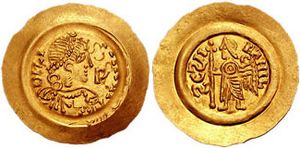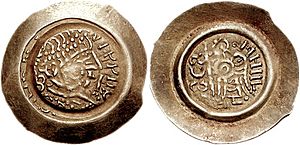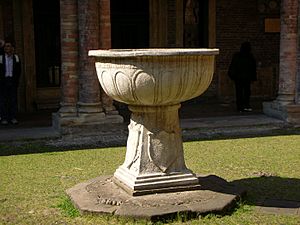Liutprand, King of the Lombards facts for kids
Quick facts for kids Liutprand |
|
|---|---|
| King of the Lombards | |

A tremissis (a type of coin) from Liutprand's time, showing the king's face
|
|
| Reign | 712-744 |
| Predecessor | Ansprand |
| Successor | Hildeprand |
| Born | c. 680 |
| Died | 744 Pavia, Italy |
| Burial | San Pietro in Ciel d'Oro |
| Religion | Chalcedonian Christianity |
Liutprand was a powerful king of the Lombards who ruled for a long time, from 712 to 744. He is remembered for making many new laws and for his successful conflicts across Italy. Many people think he was the most successful Lombard king. He is also famous for the Donation of Sutri in 728, which was the first time a king gave land directly to the Pope. This was a very important event for the future of Italy.
Contents
Early Life of Liutprand
Liutprand's early life was not easy. When he was young, his family faced danger. He was spared by his enemies because he was so young. A historian named Paul the Deacon described him as an adolescens, which means he was probably older than 19 but still in his twenties. After being released, he was able to join his father.
Liutprand's Reign as King
Liutprand became king the day before his father, Ansprand, passed away. Important leaders agreed to make Liutprand king alongside his father. His rule lasted for 31 years. He was seen as a very religious and fair lawgiver within the Lombard kingdom. He also made his sister, Imberg, the ruler of Asti.

Friends and Foes: Relations with Bavaria
When Liutprand first became king, his main friend among nearby rulers was Theodo I, the duke of Bavaria. Theodo had helped Liutprand's father become king. Theodo had also given Liutprand and his father a safe place to stay when they were forced out by another ruler in 702. This friendship became even stronger when Liutprand married Guntrud, who was from Theodo's family.
Theodo's main goal was to stop the Frankish rulers from taking over lands north of the Alps. Liutprand was more interested in controlling the mountain passes in the Italian Alps. In 712, Theodo's son, Theodebert, along with Ansprand and Liutprand, attacked Lombard strongholds. This led to Ansprand's group taking back power in Pavia.
Theodo died around 717 or 718. After his death, the Lombards' ties with Bavaria became weaker. Liutprand then focused his military efforts on taking Bavarian castles near the River Adige.
Wars with the Byzantine Empire
In the early part of his rule, Liutprand did not attack the Byzantine lands in Italy or the Pope. However, in 726, the Byzantine Emperor Leo III made a new rule against using religious images, called icons. This caused a lot of anger. Pope Gregory II told people to resist the emperor's order. A Byzantine leader in Naples was killed by a crowd for trying to destroy icons.
Liutprand saw this as a chance to attack the Byzantine areas in Italy. In 727, he crossed the Po River and captured several cities, including Bologna, Osimo, Rimini, and Ancona. He also took the seaport of Ravenna, called Classis, but could not capture Ravenna itself at first. The Byzantine leader in Ravenna was soon killed in a riot. Eventually, Ravenna surrendered to Liutprand in 737 with little fighting.
Around 713–719, Arab raiders from the Balearic Islands attacked Corsica. Liutprand stepped in to protect the Church and its people. He brought Corsica under Lombard rule around 725, even though it was officially controlled by the Byzantines. Corsica remained part of the Lombard kingdom even after the Franks conquered Lombardy.
When the Saracens (another name for Arabs) invaded Sardinia, Liutprand helped save the body of Augustine of Hippo around 720. He brought it with great honor to Pavia and placed it in the Church of Saint Peter. He also rescued other important religious items from the island quickly and at great cost.
The Donation of Sutri
After defeating the Byzantine forces, Liutprand marched towards Rome. He met Pope Gregory II at the ancient city of Sutri in 728. There, they made an important agreement. Sutri and some other towns in Lazio were given to the Pope. This was called a "gift to the blessed Apostles Peter and Paul". These lands were the first time the Pope owned territory outside of the Duchy of Rome. This event marked the beginning of the Papal States, which were lands ruled by the Pope.
Meanwhile, Emperor Leo sent a new leader, Eutychius, to take control of Italy. Eutychius made a deal with Liutprand. Liutprand would attack the Pope if the Byzantines helped him control the rebellious Lombard duchies in the south, like Spoleto and Benevento. The dukes of these areas surrendered. The new Byzantine leader then marched on Rome. Liutprand camped outside Rome and helped settle things. He returned Ravenna to the Byzantines and convinced the Pope to show loyalty to the emperor.

Friends with the Franks
After Theodo died, Liutprand changed his alliances. He became friends with Charles Martel, a powerful leader of the Franks. Liutprand even adopted Charles's son, Pepin the Short, and gave him weapons when he became a man. In 733, Liutprand made a set of six laws called the Notitia de actoribus regis. These laws aimed to stop local officials from taking public lands for themselves.
Around 735–736, Liutprand became very ill. This led him to make his nephew, Hildeprand, a co-king. In 736–737, Liutprand led his army across the Alps to help Charles Martel fight against the Moors (Muslims) in southern France.
In 738, a long period of peace ended when the Lombard duke of Spoleto, Thrasimund II, rebelled. Liutprand put down the rebellion. The rebellious dukes fled to Rome and sought protection from Pope Gregory III. Liutprand then began to conquer the area around Rome. He captured several cities and then surrounded Rome. The Pope sent a message to Charles Martel, asking for help. The Pope even gave Charles the special title of patrician. The Pope complained a lot about Liutprand, even though Liutprand was a good Christian. Liutprand just wanted his rebellious dukes to face justice. Charles Martel did not listen to the Pope's strong complaints. Instead, he sent his own people to help make peace between the Pope and Liutprand. However, both the Pope and Charles Martel died before a full agreement was reached.
Liutprand's Laws
Along with another king named Rothari, Liutprand is known as a very important figure in Lombard law. Liutprand's laws, called Liutprandi leges, showed more influence from Roman law than the laws of earlier kings.
Death of Liutprand
Soon after Pope Gregory III died in 741, Zachary became the new Pope. Liutprand happily signed a 20-year peace treaty and returned the cities he had taken from the Duchy of Rome. His long reign ended peacefully. Liutprand ruled for more years than any king before him and came closer to uniting all of Italy under one rule. He died in 744 and was buried in the church of San Pietro in Ciel d'Oro in Pavia.
In 2018, scientists studied Liutprand's bones. They found that the bones belonged to three wealthy people who had strong muscles and ate a lot of meat and fish. Two of these people lived in the 6th century, but the third person, who died around 40-50 years old, lived at the same time as Liutprand. This means it's possible that these bones belong to King Liutprand himself!
Sources
The main source of information about Liutprand's life is the book Historia Langobardorum by Paul the Deacon. This book was written after 787 and tells the story of the Lombards from 568 until Liutprand's death in 744. Even though it was written by a Lombard from their point of view, it also has a lot of information about the Byzantine Empire, the Franks, and other groups.
Images for kids
See also
 In Spanish: Liutprando para niños
In Spanish: Liutprando para niños


